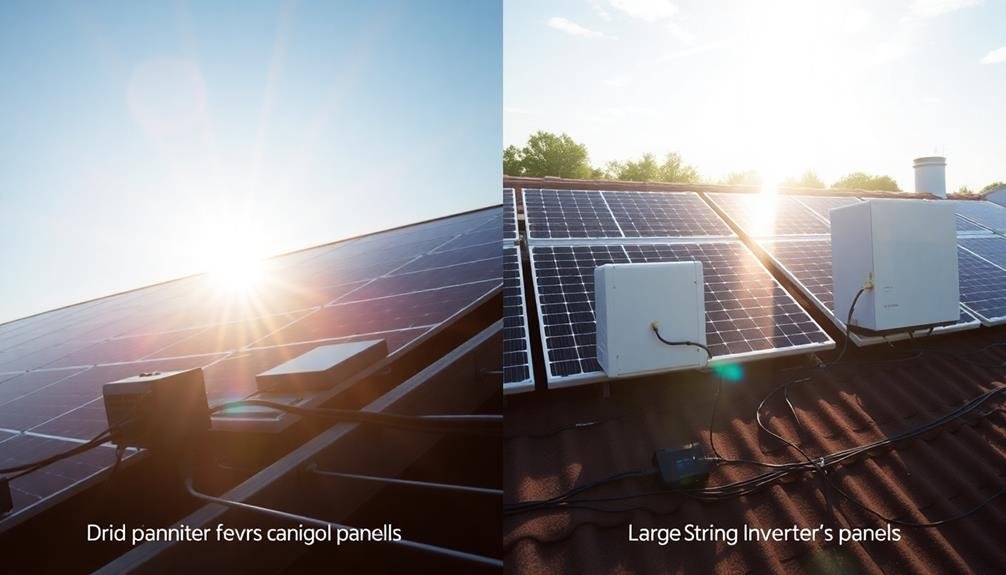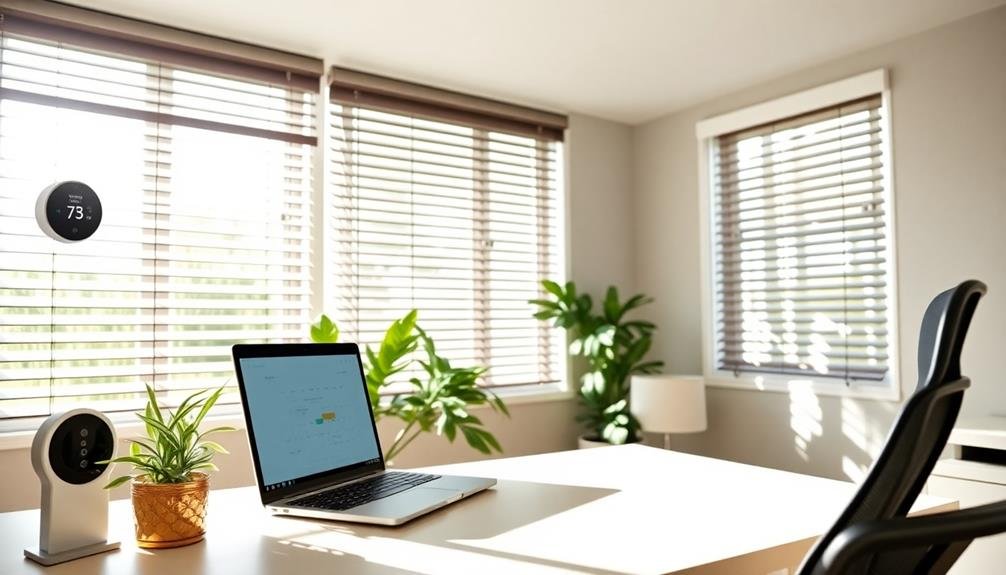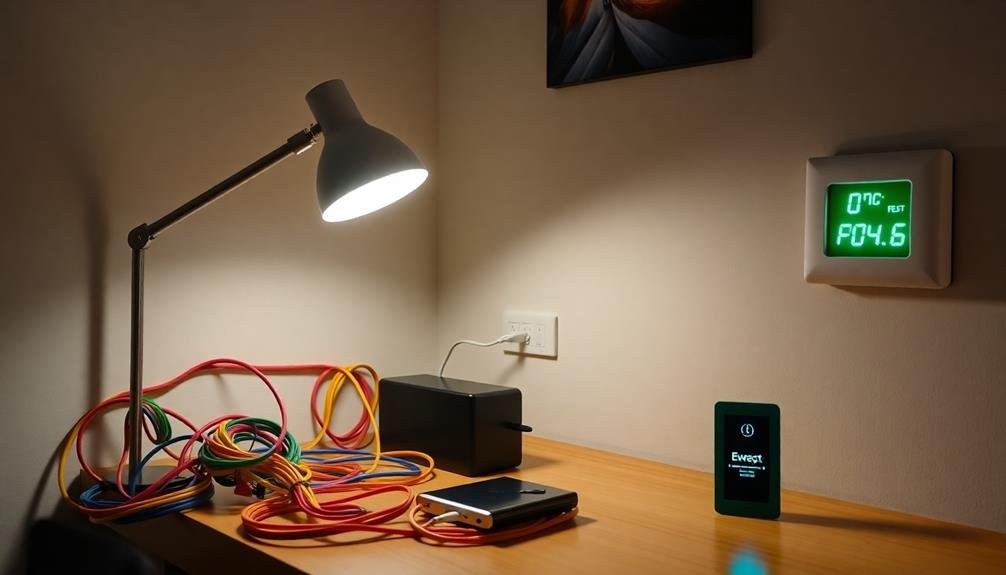When choosing between micro-inverters and string inverters for your solar installation, you'll need to weigh several factors. Micro-inverters optimize each panel individually, offering better performance in shaded conditions and easier scalability. They're typically more expensive upfront but have longer lifespans. String inverters are less costly per watt and work well in uniform sunlight, but they're affected by the lowest-performing panel in the series. Your decision should consider roof layout, shading, system size, and long-term goals. Safety features, maintenance requirements, and environmental impact also play significant roles. Exploring these aspects in depth will help you make the best choice for your unique solar setup.
Understanding Solar Inverter Types

Diving into the world of solar energy, you'll quickly encounter two main types of inverters: micro-inverters and string inverters. These devices play a vital role in converting the direct current (DC) produced by your solar panels into usable alternating current (AC) for your home.
String inverters are the traditional choice, connecting multiple solar panels in a series. They're typically installed at ground level or on the side of your house, making them easily accessible for maintenance.
One string inverter can handle the output from an entire array of panels, which can be cost-effective for larger installations.
Micro-inverters, on the other hand, are attached to each individual solar panel. They convert DC to AC right at the panel level, offering greater flexibility and performance enhancement.
This setup allows each panel to operate independently, which can be beneficial if some panels are shaded or not performing at their best.
Understanding these differences is essential when deciding which type of inverter is best for your solar installation.
Factors like roof layout, shading issues, and system size will influence your choice between micro-inverters and string inverters.
Efficiency and Power Output

When comparing micro-inverters and string inverters, efficiency and power output are key factors to evaluate.
Micro-inverters typically offer higher efficiency, as they optimize each panel individually. This means you'll get maximum power from every panel, even if some are shaded or dirty.
String inverters, while generally less efficient, can still perform well in ideal conditions with uniform sunlight exposure.
Power output is another vital consideration. Micro-inverters allow for easier system expansion, as you can add panels without worrying about string sizing. They also provide panel-level monitoring, giving you detailed insights into your system's performance.
String inverters, however, often have higher overall power capacity, making them suitable for larger installations.
Here's a quick comparison of efficiency and power output features:
- Micro-inverters optimize each panel individually
- String inverters perform best with uniform sunlight exposure
- Micro-inverters allow for easier system expansion
- String inverters often have higher overall power capacity
- Micro-inverters provide panel-level monitoring and data
When choosing between micro and string inverters, consider your specific installation needs, budget, and long-term goals.
Both types have their strengths, and the best choice depends on your unique situation and priorities.
Installation Complexity and Costs

Although both micro-inverters and string inverters serve the same purpose, their installation processes differ greatly in complexity and cost. Micro-inverters are typically easier to install, as you'll attach them directly to each solar panel. This simplifies the process and reduces the need for complex wiring. However, the cost per unit is higher, which can increase your overall installation expenses.
String inverters, on the other hand, require more intricate wiring and planning. You'll need to connect multiple panels in series before linking them to a central inverter. This process can be more time-consuming and may require additional expertise. However, the cost per watt is generally lower for string inverters, potentially reducing your total system cost.
| Aspect | Micro-Inverters | String Inverters |
|---|---|---|
| Installation Time | Faster | Slower |
| Wiring Complexity | Low | High |
| Labor Costs | Lower | Higher |
When deciding between the two, you'll need to weigh the upfront costs against long-term benefits. While micro-inverters may have a higher initial price, their simpler installation and potential for increased energy production could offset this over time. Conversely, string inverters' lower upfront cost might be attractive if you're working with a tight budget.
Monitoring and Diagnostics

Monitoring and diagnostics capabilities differ markedly between micro-inverters and string inverters.
With micro-inverters, you'll enjoy panel-level monitoring, allowing you to track the performance of each individual solar panel in your system. This granular data helps you quickly identify any underperforming panels or potential issues.
String inverters, on the other hand, typically provide system-level monitoring, which gives you an overview of your entire solar array's performance but may not pinpoint specific panel problems.
Micro-inverters offer real-time data and alerts, enabling you to address issues promptly and minimize energy loss. String inverters can also provide monitoring, but the level of detail may be less thorough.
When it comes to diagnostics, micro-inverters make it easier to troubleshoot and isolate problems, potentially reducing maintenance costs and downtime.
Key differences in monitoring and diagnostics:
- Panel-level vs. system-level monitoring
- Granularity of performance data
- Speed of issue detection and resolution
- Ease of troubleshooting and problem isolation
- Potential impact on maintenance costs and system uptime
Consider your monitoring needs and preferences when choosing between micro-inverters and string inverters for your solar installation.
The right choice will depend on your desire for detailed insights and your willingness to invest in more advanced monitoring capabilities.
Scalability and System Expansion

Solar system growth presents different challenges and opportunities depending on your choice of inverter technology.
With microinverters, you'll find it easier to expand your system over time. You can add panels one by one, each with its own inverter, without worrying about reconfiguring the entire system. This flexibility is particularly useful if you're uncertain about your future energy needs or have limited initial budget.
String inverters, on the other hand, require more planning for expansion. You'll need to take into account the inverter's capacity when adding panels. If you exceed its limits, you might've to replace the entire inverter, which can be costly.
However, string inverters can handle larger systems more efficiently, making them suitable for commercial installations or homes with significant energy demands.
When scaling up, microinverters maintain consistent performance across the system, even if you add panels in less-than-ideal locations.
With string inverters, you'll need to carefully plan panel placement to avoid compromising the entire string's output.
Ultimately, your choice depends on your long-term goals, budget, and property constraints. Think about future expansion possibilities when making your initial inverter decision to guarantee your solar system can grow with your needs.
Shading and Panel Mismatch

When it comes to optimizing solar panel performance, shading and panel mismatch are essential factors to take into account. Micro inverters have a distinct advantage in these situations, as they allow each panel to operate independently. This means that if one panel is shaded or underperforming, it won't affect the entire system's output.
String inverters, on the other hand, are more susceptible to these issues, as panels are connected in series and operate at the level of the lowest-performing panel.
You'll find that micro inverters are particularly beneficial in installations where:
- Partial shading occurs due to trees, chimneys, or nearby structures
- Panels face different directions or have varying tilt angles
- There's a possibility of snow or debris accumulation on some panels
- Future obstructions might arise, such as growing trees or new construction
- Panel degradation over time could lead to mismatched performance
With string inverters, you can mitigate some of these issues by using power optimizers or careful system design.
However, micro inverters offer a more robust solution for maximizing energy production in less-than-ideal conditions. They guarantee that each panel operates at its peak efficiency, regardless of environmental factors or panel variations, ultimately leading to higher overall system performance.
Maintenance and Longevity

When considering maintenance and longevity, you'll find key differences between micro and string inverters.
You'll want to weigh factors like the ease of replacing individual components, the system's monitoring capabilities for quick problem detection, and the typical lifespan and warranty offerings of each inverter type.
These aspects can greatly impact your solar system's long-term performance and cost-effectiveness.
Ease of Replacement
Concerning maintenance and longevity, micro and string inverters differ markedly in their ease of replacement. Micro inverters are typically easier to replace, as you can address individual panel issues without disrupting the entire system. If one micro inverter fails, you'll only need to replace that specific unit, minimizing downtime and labor costs.
In contrast, when a string inverter fails, you'll need to replace the entire unit, which can be more complex and time-consuming.
String inverters are usually located in a central location, making them more accessible for replacement. However, their larger size can make the physical replacement process more challenging. Micro inverters, being smaller and distributed across your roof, may require more effort to access but are simpler to swap out individually.
Here's a quick comparison of replacement ease:
- Micro inverters: Individual replacement, less system downtime
- String inverters: Whole unit replacement, potentially longer downtime
- Micro inverters: Easier to diagnose specific panel issues
- String inverters: Simpler access in central location
- Micro inverters: More frequent but smaller-scale replacements
Consider these factors when choosing between micro and string inverters for your solar installation, as they'll impact your long-term maintenance strategy and costs.
System Monitoring Capabilities
System monitoring capabilities often play an essential role in the maintenance and longevity of solar inverter systems. When comparing micro and string inverters, you'll find distinct differences in their monitoring capabilities.
Micro inverters offer panel-level monitoring, allowing you to track the performance of each individual solar panel. This granular data helps you quickly identify underperforming panels or potential issues. You'll receive real-time information on energy production, voltage, and current for every panel in your system. This detailed monitoring makes it easier to diagnose problems and perform targeted maintenance.
String inverters, on the other hand, typically provide system-level monitoring. You'll get data on the overall performance of your solar array, but it may be more challenging to pinpoint specific issues with individual panels. However, some string inverter systems now offer optimizers that can provide panel-level monitoring, bridging the gap between the two technologies.
Both types of inverters usually offer remote monitoring capabilities, allowing you to access your system's data through web portals or mobile apps. This feature enables you to keep an eye on your solar system's performance from anywhere, ensuring you can promptly address any issues that arise.
Lifespan and Warranties
The lifespan and warranty of your solar inverter system play an essential role in determining its long-term value and reliability. When comparing micro and string inverters, you'll find differences in their expected lifespans and warranty offerings.
Micro inverters typically last longer than string inverters, with an average lifespan of 25 years compared to 10-15 years for string inverters. This longer lifespan often translates to better warranties, with many micro inverter manufacturers offering 25-year warranties. String inverter warranties usually range from 5 to 12 years, though extended warranties may be available for purchase.
Consider these factors when evaluating inverter lifespan and warranties:
- Initial cost vs. long-term value
- Replacement frequency and associated costs
- Warranty coverage and terms
- Manufacturer reputation and support
- System performance guarantees
While micro inverters may have a higher upfront cost, their longer lifespan and more thorough warranties can provide better long-term value.
String inverters, on the other hand, may require replacement before your solar panels reach the end of their useful life. When choosing between micro and string inverters, carefully weigh the potential maintenance costs and warranty coverage against your budget and long-term energy goals.
Safety Considerations

When considering safety, you'll find that both micro and string inverters have distinct advantages.
Micro inverters often excel in rapid shutdown compliance, meeting stringent safety regulations more easily than their string counterparts.
However, string inverters may offer safer maintenance procedures, as technicians can work on a centralized unit rather than accessing multiple rooftop devices.
Rapid Shutdown Compliance
Since 2014, rapid shutdown requirements have become increasingly significant in solar installations. These regulations aim to enhance safety for firefighters and first responders by quickly de-energizing solar panels during emergencies.
When comparing micro and string inverters, you'll find that microinverters have a distinct advantage in meeting rapid shutdown compliance.
Microinverters are inherently compliant with rapid shutdown requirements, as they're installed at each panel and can quickly reduce voltage to safe levels. String inverters, on the other hand, often require additional equipment to achieve compliance, which can increase installation complexity and cost.
Here are key points to take into account regarding rapid shutdown compliance:
- Microinverters automatically meet NEC 2017 and 2020 rapid shutdown requirements
- String inverters may need extra components like DC optimizers or rapid shutdown devices
- Compliance can impact system design, installation time, and overall costs
- Rapid shutdown regulations vary by state and local jurisdiction
- Future updates to NEC codes may further influence inverter choices
When planning your solar installation, it's essential to take into account rapid shutdown compliance.
While microinverters offer built-in compliance, string inverter systems can still meet requirements with proper planning and additional components. Ultimately, your choice should balance safety, cost, and performance considerations.
Maintenance Safety Differences
Safety considerations play an essential role when maintaining solar inverter systems. When comparing micro and string inverters, you'll find significant differences in maintenance safety protocols.
With micro inverters, you're dealing with lower DC voltages at the panel level, reducing shock risks during maintenance. You can safely work on individual panels without shutting down the entire system. In contrast, string inverters require more caution due to high DC voltages running through the system.
Here's a comparison of maintenance safety aspects:
| Aspect | Micro Inverters | String Inverters |
|---|---|---|
| Voltage Levels | Low DC (≤60V) | High DC (up to 1000V) |
| Isolation | Panel-level | System-wide |
| Shutdown | Individual panels | Entire string |
| Troubleshooting | Easier, localized | More complex |
| Arc Flash Risk | Lower | Higher |
When maintaining micro inverters, you'll find it easier to isolate problems and perform repairs without exposing yourself to high voltages. String inverters, however, require you to take extra precautions, including proper PPE and specialized training. You'll need to shut down larger sections of the array, potentially impacting overall system performance during maintenance. Always follow manufacturer guidelines and local regulations for both types to guarantee safe maintenance practices.
Environmental Impact and Sustainability

Considering the environmental impact and sustainability of solar inverters, it's vital to examine both micro and string inverters. Both types contribute to renewable energy production, but they differ in their lifecycle impacts and efficiency.
Micro inverters typically have a longer lifespan, reducing the need for replacements and minimizing electronic waste. They're also more efficient in partial shading conditions, potentially generating more clean energy over time. However, they require more materials to manufacture, as each panel needs its own inverter.
String inverters, on the other hand, use fewer materials overall, as one unit serves multiple panels. They're easier to recycle due to their centralized design but may need replacement sooner than micro inverters.
When evaluating environmental impact and sustainability, consider:
- Energy payback time
- Material usage and sourcing
- Recyclability of components
- Efficiency in various weather conditions
- Potential for future upgrades
Ultimately, both micro and string inverters play significant roles in solar energy systems. Your choice should depend on your specific installation requirements, climate conditions, and long-term sustainability goals.
Frequently Asked Questions
Can I Use Both Micro and String Inverters in a Single Solar System?
Yes, you can use both micro and string inverters in a single solar system. It's called a hybrid system. You'll typically use string inverters for the main array and add microinverters for panels in shaded or less advantageous areas.
How Do Micro and String Inverters Affect My Home's Resale Value?
Your home's resale value can benefit from both micro and string inverters. You'll likely see a higher boost with microinverters due to their panel-level monitoring and optimization. However, any solar system generally increases property value.
Are There Any Specific Weather Conditions That Favor One Inverter Type?
You'll find that micro-inverters perform better in partially shaded conditions. They're also more resilient in extreme temperatures. String inverters, however, can handle high winds better due to their centralized installation. Consider your local climate when choosing.
Do Utility Companies Prefer One Type of Inverter Over the Other?
You'll find that utility companies don't typically prefer one inverter type over another. They're more concerned with safety, grid stability, and compliance with their interconnection standards. Your choice should focus on your specific installation needs and local regulations.
Can Inverter Type Impact My Eligibility for Solar Incentives or Rebates?
Your inverter choice can affect your eligibility for incentives. Some programs may require specific inverter types or features. It's best to check with local utility companies and incentive providers to verify you're maximizing your potential benefits.
In Summary
You've now explored the key differences between micro and string inverters. Consider your specific needs, budget, and installation site when choosing. Micro inverters offer flexibility and individual panel optimization but come at a higher cost. String inverters are more affordable and easier to maintain but less adaptable to shading. Weigh the pros and cons carefully, and don't hesitate to consult a solar professional for personalized advice tailored to your unique situation.





Leave a Reply